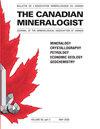Chlorine-Rich Amphiboles from the Grenville-Age Hudson Highlands of New York State
IF 1.5
4区 地球科学
Q3 MINERALOGY
引用次数: 0
Abstract
Some Grenville-age rocks exposed in the uplifted region of the Hudson Highlands of southern New York are amphibole-dominant igneous rocks. The amphibole-rich rocks, which are locally pegmatitic in nature, are associated with magnetite ore and coarse-grained syenite; the ore was discovered and mined from the middle of the 18th century to the end of the 19th century. The amphiboles have attracted the attention of many researchers for nearly two centuries. Chemical analyses demonstrate that they are pargasite or hastingsite in composition and are particularly rich in Cl and K. High-precision crystal structure analyses of 11 Cl-rich amphiboles from the Hudson Highlands (0.0134纽约州格伦维尔时代哈德逊高地的含氯两栖动物
暴露在纽约南部哈德逊高地隆起区域的一些格伦维尔时代的岩石是以角闪石为主的火成岩。富含角闪石的岩石是局部伟晶岩,与磁铁矿和粗粒正长岩有关;该矿是在18世纪中期至19世纪末发现和开采的。近两个世纪以来,角闪石一直吸引着许多研究人员的注意。化学分析表明,它们在成分上是共气化岩或辉长岩,特别富含Cl和K。对哈德逊高地11种富含Cl的角闪石(0.0134
本文章由计算机程序翻译,如有差异,请以英文原文为准。
求助全文
约1分钟内获得全文
求助全文
来源期刊

Canadian Mineralogist
地学-矿物学
CiteScore
2.20
自引率
22.20%
发文量
45
审稿时长
4-8 weeks
期刊介绍:
Since 1962, The Canadian Mineralogist has published papers dealing with all aspects of mineralogy, crystallography, petrology, economic geology, geochemistry, and applied mineralogy.
联系我们:info@booksci.cn
Book学术提供免费学术资源搜索服务,方便国内外学者检索中英文文献。致力于提供最便捷和优质的服务体验。
Copyright © 2023 布克学术 All rights reserved.
京ICP备2023020795号-1
 京公网安备 11010802042870号
京公网安备 11010802042870号
京ICP备2023020795号-1

Book学术文献互助群
群 号:604180095

 求助内容:
求助内容: 应助结果提醒方式:
应助结果提醒方式:
